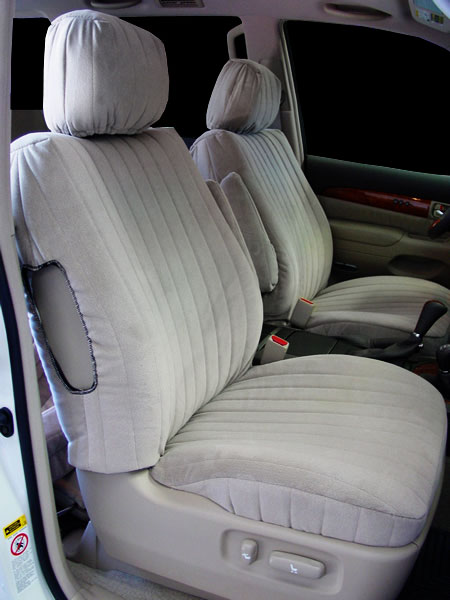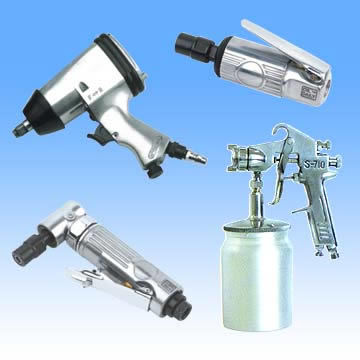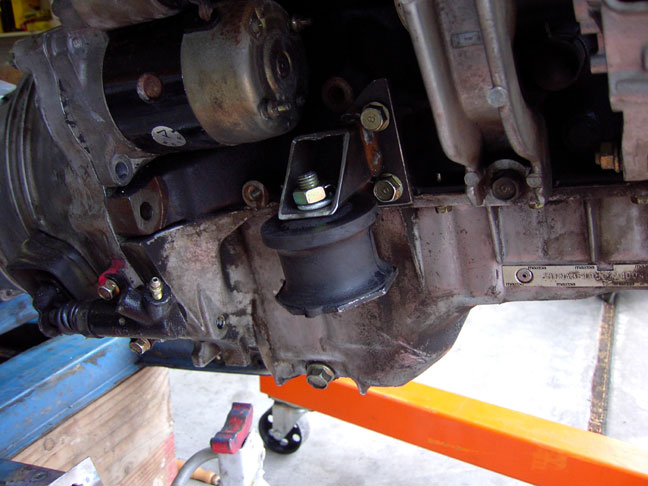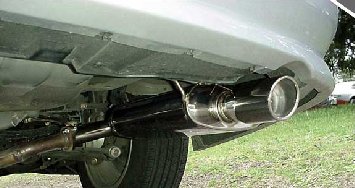When your car or truck A/C is not blowing "cold air", the first thought is to panic. Money signs are going through your mind. Your A/C is broken and the repair is going to be expensive. This article takes the mystery out of automotive air conditioning and serves as a primer so that you can make common repairs yourself and save MONEY on professional repairs.

A/C Principles
There are books and publications that contain volumes of information on the subject of air conditioning repair. This information is often too technical for the you to learn how-to fix your auto air conditioning system.
In the nutshell, here is all that you need to know about the fundamentals of refrigeration so that you can fix your auto air conditioning system yourself.
Air conditioning is the process in which air inside the passenger compartment is cooled, dried, and circulated. Heat is removed from inside the vehicle and transferred to the outside air.
All air conditioners whether, it is an auto A/C, household refrigerator or home HVAC, work on the same principles. Namely, a liquid refrigerant is changed to a gas and then back to a liquid. If a change-of-state of the refrigerant is to take place, heat transfer must take place. The two (2) rules that apply to refrigerant are:
1. Refrigerant in a gaseous state collects, absorbs, and holds heat. 2. Refrigerant in a liquid state releases that heat.
A/C Operation and Components
For your auto A/C to blow "cold air", R-134A refrigerant must pass through and change state in three (3) components, one (1) receiver-dryer, and one (1) expansion valve that makes up the closed auto air conditioning system. The components of the system are:
1. Compressor - A device that pressurizes the heated refrigerant..
2. Condenser - A radiator for refrigerant that transfers the heat that was absorbed in the passenger compartment to the cooler air.
3. Evaporator - Is a small radiator located under dash in the passenger compartment. Liquid refrigerant entering the evaporator creates a pressure loss. The liquid refrigerant absorbs heat from the air blowing across the evaporator. It then boils and changes state to vapor before it enters the suction port of the compressor.
4. Receiver-Dryer - Is a canister that stores the liquid refrigerant when the compressor is not running. It contains a desiccant that removes moisture from the system.
5. Expansion Valve - Is a metering device that controls the amount of refrigerant to the evaporator.

A/C Quick Check
A check that can easily be made to check the health of the A/C system is the "feel check". With engine running, turn the auto A/C control to "ON" and the blower on "high". Take a test drive to warm the engine until the A/C system pressures stabilize. Raise the hood. With the A/C "On", locate the large tubing connected and routed from the compressor (low side) to the expansion valve (inlet side) of the evaporator. Next, locate the small tubing that is connected to the discharge-side of the compressor and routed to the outlet side of the evaporator. When you feel these two (2) lines, you should observe these results:
1. The low-side line should feel "cool" to the touch. 2. The high-side line should feel "warm" to the touch.
If the high-side tubing is not warm and the low-side is not cool, further tests will have to be made as the system is not doing any work. There is an internal problem; such as, a defective component or a leak in your A/C system.
Testing A/C System
Before system temperature tests can be made, a checklist should be followed (below) to setup for testing the A/C system:
1. Set the A/C "ON-OFF" switch to "ON". 2. Set the temperature control to "maximum cooling". 3. Set the blower on "high" or the highest number on the control switch. 4. Temperature inside passenger compartment should be stable and getting cooler. 5. Engine speed must be a minimum of 1500 rpm's. 6. All windows should be be in the "UP" position.
Check Temperature
Your compact car or truck has a small capacity A/C system and a loss of "cooling" would be more noticeable than a larger capacity auto A/C system. If a noticeable loss of "cooling" capacity is noticed, a temperature check at the vent registers should be made. This check can be made with an instant read or digital temperature thermometer.. The discharge air from the vents in the passenger compartment should range from 38 to 42 degrees F.
A/C System Diagnosis
Assuming that the discharge air test measured at the vent registers is out-of-range, a system pressure test will have to be made. Professional A/C technicians connect a tool known as the manifold gauge set to the "low" and "high" side service valves of the system. For you to diagnose and look inside the A/C, it will be necessary to become proficient in the use of the manifold gauge set.
A manifold gauge set that is suitable for the needs can be purchased at most auto supply stores and Internet A/C tool and supply store fronts for less than $50.00. TIP: Look for a gauge set that has a built-in sight glass.
Locate the "low" and "high" side service valves.. Connect the hoses (they are a snap connector fit) to the service valves in the following manner:.
1. Connect the blue hose of the gauge set to the "low-side" service valve of the compressor. 2. Connect the red hose of the gauge set to the "high-side service valve of the compressor. 3. The yellow hose of the gauge set is connected to a vacuum pump or a refrigerant can to add refrigerant to the system. The yellow hose is not connected to the system at this time.
Static Test
If you find an out-of-range temperature reading, the manifold gauge set should be installed on the "low" and "high-side" service valves. With the engine "OFF" and the compressor and clutch not engaged, the blue "low-side" and red "high-side" gauges should show equal readings of approximately 80 to 120psi. These readings would indicate that there is a refrigerant charge in your A/C system. If the readings were 50psi on each gauge, this would indicate that there is refrigerant in the system but a LOW CHARGE. If the readings were 10 to 20psi on each gauge would indicate that there is little or no refrigerant in your A/C system.
Engine Running Test
Start the engine,.turn the A/C switch"ON" with the blower on "high" and run for a minimum of fifteen (15) minutes. Observe the reading on the manifold gauge set. TIP: A manifold gauge set with a built-in sight glass (mentioned above) will save you diagnostic time as most A/C systems do not have a sight glass built-in the receiver-dryer on the high side of the system.
With this feature, you look for bubbling refrigerant oil and refrigerant in the sight glass on the manifold. Oil moving through the glass would indicate that the compressor and clutch are engaged. Refrigerant is being moved from the low-side throughout the A/C system in the refrigeration cycle.
Low Charge
With the engine running, A/C switch "ON", and the manifold gauge set installed, a "low-side" pressure reading of 20psi over 150psi would indicate that your A/C system has a LOW CHARGE. The low reading of 150psi on the "high-side" gauge would be the tell tale that the system is doing very little work. A LOW CHARGE usually is an indicator that there is a refrigerant leak from a component on the "low" or "high-side" of the A/C system. A refrigerant leak in the system would have to be repaired for the A/C system to blow "cold air". TIP: REFRIGERANT DOES NOT WEAR OUT, IT LEAKS OUT. Some symptoms to look for a LOW CHARGE condition are:
1. Compressor clutch short cycling. 2. Clutch will not engage. 3. Little or no cooling. 4. Oily residue on hoses and components.
Leak Checking
For your A/C system to blow "cold air", refrigerant leaks will have to be found and repaired. Usually, leaks in an A/C system are minor and can be fixed with a screwdriver or hand tools. Most A/C systems use schrader valves for easy connection of the manifold gauge set. That said, these are no more than overgrown bicycle valves that use a valve core. When you are checking a system, the valves are the first place check for a leak. Other targets; such as, oil residue on hoses connected to the compressor is the second place that should be checked. TIP: When tightening the bolts to the suction and discharge ports of the compressor with hand tools, do not over tighten. Rubber 0-rings are placed on the suction and discharge ports of the compressor for sealing. The seals will create a leak when over tightened. Only tighten snug.
When your A/C system has a LOW CHARGE, a refrigerant charge will have to added to check for the leak. Refrigerant that contains a dye for leak checking a system is used for this purpose. The manifold gauge set, refrigerant, and a can tap valve will be needed to add refrigerant to check for a leak in the system.
Connect the manifold gauge set as discussed above. Connect the yellow hose to the can tap valve and front seat (turn clockwise) the valve. Close the blue gauge on the manifold gauge set. Open the valve on the can tap valve. Slowly open the valve on the blue or "low-side" gauge and let the refrigerant flow from the refrigerant can into the system until you see a reading of 60psi on the "low-side" gauge. TIP: Placing the refrigerant can in a pan of hot water will allow the vapor refrigerant to enter the A/C system quicker. WARNING: Do not invert the refrigerant can. Doing so will allow liquid refrigerant to enter the system resulting in a ruined compressor.
Professional A/C technicians use an electronic leak detector to find leaks in an system. Use a battery-powered UV leak detector kit and special UV glasses. This kit can be purchased at auto supply stores and Internet A/C supply store fronts.
The UV glasses should be worn when checking for leaks. Simply place the tip of the detector on a fitting or connection to each component to be checked in the A/C system. When a leak is found, a light greenish color will be seen through the UV glasses.
Air Flow
An often overlooked cause of your A/C system not blowing "cold air" is debris that clogs the condenser. Bugs, plastic bags, and leaves from city and highway driving will prevent air from passing through the fins of the condenser. The condenser should be cleaned with a cleaning solvent. Bent fins on the condenser should be straightened with a fin comb.
Restrictions
A restriction is a condition that is a blockage. Usually, it is traced to the outlet side of the condenser. Some form of debris has formed causing a restriction of refrigerant flow through the condenser tubes.. The passages in the tubes of most condensers that are used in compact cars and trucks are very small. An effective way to diagnose a restriction in your A/C system is the manifold gauge set. The "high-side" (red) gauge would move into the DANGER zone, over 300psi.
System Repairs
When a system has been opened, and a component removed, moisture has entered the system. For your A/C to blow "cold air", that moisture will have to be removed with the aid of a vacuum pump.
At this stage of the repair, you have two (2) choices to finish the repair of your A/C system. The first choice is take the car or truck to an A/C professional. At their shop, they will evacuate the system, check your work, and recharge the A/C system for a fee.
The second choice is to repair your A/C system yourself. You will need to borrow or buy a vacuum pump to finish the repair. A small 2-stage vacuum pump that is designed for automobile refrigeration systems is available for less than $100.00.
After replacing a component, moisture has entered the system during the repair. For the A/C system to blow "cold air" the moisture will have to be removed. Install the manifold gauge set to your car or truck service valves as described above. After repairs, your A/C system is evacuated and recharged by applying the below steps:
1. Blue hose to the "low-side" service valve.
2. Red hose to the "high-side service valve.
3. Yellow hose to the suction port of the vacuum pump.
4. Close the hand valve to the vacuum pump.
5. Back seat (open) the hand valves on the blue and red gauges of the manifold gauge set.
6. Connect the electrical power to the vacuum pump.
7. Open the hand valve on the vacuum pump.
8. Run the vacuum pump for three (3) minutes.
9. The needle on the "low-side" gauge (blue) show should be in a vacuum at 28.3hg.
10. A system with no leaks will pull a vacuum of 28.3hg in three (3) minutes.
11. If the needle of the blue gauge did not fall to 28.3hg, the evacuation will have to be aborted as there is a leak in your car or truck A/C system.
12. The leak will have to be found in the A/C system using the UV detector and UV glasses.
13. Once the leak has been found and repaired, continue the evacuation steps as described above for 25 minutes.
14. Front seat (close) the hand valves on the blue and red gauges and observe the needle on the blue gauge.
15. The needle should hold steady at 29hg, indicating a tight system with no leaks.
16. Any needle movement toward "0" on the blue "low-side" gauge would indicate a leak in the system and the evacuation would have to be aborted and conduct a search for the leak.
16.Look in the owners manual or service manual for the factory recommended refrigerant charge. It is usually from 16 to 28 ounces.
17.Attach the can tap valve to a can of refrigerant Make sure that the tap valve hand valve is front seated (closed).
18. Turn the A/C control switch to the "ON" position and blower switch to "high".
19. Start the engine and run at 1500rpm's.
20. Place the refrigerant can in a pan of hot water. Warning: Do not invert the can for this process as liquid would enter the system and ruin the reed valves of the compressor.
21. Continue this process until the factory charge (approximately 2 1/2 cans) has entered the system.
22. Shutoff your car or truck engine and let the A/C system stabilize. When the readings on the red and blue gauges are equal, remove the blue "low-side" hose from the service valve.
23. Restart the engine and remove the red "high-side" hose from the service valve.
24. Close the hood and take your car or truck for a three (3) mile test drive.
25. Place an instant read or digital thermometer in the vent register in the passenger compartment.
26. The temperature should range from 38 to 42 degrees F on a 90-degree day.
Tools and Materials
1. Manifold gauge set 2. Vacuum pump 3. Hand tools 4. Battery powered UV leak detector 5. Can tap valve 6. 134A refrigerant dye 7. 134A refrigerant 8. Instant read temperature thermometer 9. Digital temperature thermometer









































